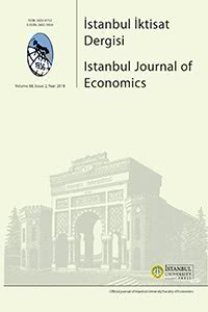Kuşak ve Yol Projesinin Çekim Modeli Kapsamında Türkiye Dış Ticaretine Olası Etkileri: Ulaşım Modları Yaklaşımı
Kuşak ve Yol Projesi, Ulaşım modları, Çekim modeli, Dış ticaret
The Possible Effects of the Belt and Road Initiative on Turkey’s Foreign Trade within the Scope of the Gravity Model: A Modes of Transportation Approach
___
- Anderson, J. E. (2011). The gravity model. Annual Review of Economics, 3(1), 133-160. google scholar
- Baniya, S., Rocha, N., & Ruta, M. (2020). Trade effects of the new silk road: A gravity analysis. Journal of Development Economics, 146, Article 102467. https://doi.org/10.1016/j.jdeveco.2020.102467. Bernardini, R., &
- Bertarelli, S. (2015).Trade costs in bilateral trade flows: heterogeneity and zeroes in structural gravity models. The World Economy, Vol. 38, Issue 11, pp. 1744-1762, Available at SSRN: https://ssrn.com/abstract=2717222 or http://dx.doi.org/10.1111/twec.12259. google scholar
- Carrere, C. (2004). African regional agreements: Impact on trade with or without currency unions. Journal of African Economies, 13(2), 199-239. google scholar
- Carrere, C. (2006). Revisiting the effects of regional trade agreements on trade flows with proper specification of the gravity model. European Economic Review, 50(2), 223-247. google scholar
- Fardella, E., & Prodi, G. (2017). The belt and road initiative impact on Europe: an Italian perspective. China & WorldEconomy. 25. 125-138. . https://doi.org/10.1111/cwe.12217. google scholar
- Foo, N., Lean, H. H., & Salim, R. (2019). The impact of China's one belt one road initiative on international trade in the ASEAN region. The North American Journal of Economics and Finance, 54, 101089. https://doi.org/10.1016Zj.najef.2019.101089. google scholar
- Grossman, G. M., & Helpman, E. (1994). Endogenous innovation in the theory of growth. Journal of Economic Perspectives, 8(1), 23-44. google scholar
- Guo, X., Zhang, J., Xue, J., & Yan, T. (2017). A research on the gravity model of Chinas oil trade in the strategic context of One Belt One Road. Journal Of Economics And International Finance, 9(10), 95-102. https://doi.org/10.5897/jeif2017.0858. google scholar
- Haralambides H. & Merk O. (2020), The belt and road initiative: impacts on global maritime trade flows, International Transport Forum Discussion Papers, No. 2020/02, OECD Publishing. https:// doi.org/10.1787/2281f06f-en. google scholar
- Helpman, E., & Hoffmaister, A. (1997). North-South R&D spillovers. The Economic Journal, 107(440), 134-149. google scholar
- Herrero, A. G., & Xu, J. (2017). China's belt and road initiative: Can Europe expect trade gains? China & World Economy, 25(6), 84-99. google scholar
- Hummels, David L., & Georg Schaur. 2013. "Time as a Trade Barrier.” American Economic Review, 103(7): 2935-59. google scholar
- Irshad, M., Xin, Q., Hui, Z., & Arshad, H. (2018) An empirical analysis of Pakistan's bilateral trade and trade potential with China: A gravity model approach, Cogent Economics & Finance, 6(1), https://doi.org/10.1080/23322039.2018.1504409. google scholar
- Kabir, M., Salim, R., & Al-Mawali, N. (2017). The gravity model and trade flows: Recent developments in econometric modeling and empirical evidence. Economic Analysis and Policy, 56, 60-71. google scholar
- Kim,. Mariano P. & Abesamis J. (2021) Trade impact of reducing time and costs at borders in the central Asia regional economic cooperation region. Emerging Markets Finance and Trade, Taylor & Francis Journals, vol. 58(9), pages 2602-2619, July. https://doi.org/10.1080/154049 6X.2021.2007877. google scholar
- Kohl, T. (2019). The belt and road initiatives effect on supplychain trade: Evidence from structural gravity equations. Cambridge Journal of Regions, Economy and Society, 12(1), 77-104. google scholar
- Larch, M., & Yotov, Y (2016). General equilibrium trade policy analysis with structural gravity. World Trade Organizations (WTO), Economic Research and Statistics Division. google scholar
- Lee, Euri. (2019). The belt and road initiative: impact on trade patterns between China and central Asia. East Asian Community Review. 1. https://doi.org/10.1057/s42215-019-00015-3. google scholar
- Liu, A., Lu, C., & Wang, Z. (2020). The roles of cultural and institutional distance in international trade: Evidence from China's trade with the Belt and Road countries. China Economic Review, 61, 101234. https://doi.org/10.1016/j.chieco.2018.10.001. google scholar
- Mao, H., Liu, G., Zhang, C., & Atif, R. (2019). Does belt and road initiative hurt node countries? A study from export perspective. Emerging Markets Finance and Trade, 55(7), 1472-1485. google scholar
- OECD (2018), Business and Finance Outlook. Erişim: https://www.oecd-ilibrary.org/finance-and-investment/oecd-business-and-finance-outlook-2018_9789264298828-en google scholar
- Ramasamy, Bala & Yeung, Matthew. (2019). China's one belt one road initiative:the impact of trade facilitation versus physical infrastructure on exports. The World Economy. 42. https://doi. org/10.1111/twec.12808. google scholar
- Silva, J. S., & Tenreyro, S. (2006). The log of gravity. The Review of Economics and Statistics, 88(4), 641-658. https://doi.org/10.1162/rest.88.4.641. google scholar
- Swallow, Y., Deb, P., Furceri, D., Jimenez, D., & Ostry, J. (2022). Shipping Costs and Inflation. IMF Working Paper. google scholar
- Tinbergen, J. (1962). Shaping the World Economy; Suggestions for an International Economic Policy. Books (Jan Tinbergen). Twentieth Century Fund, New York. Erişim: http://hdl.handle. net/1765/16826TÜİK (2013-2019), Dış Ticaret Mikro Veri Seti. google scholar
- World Bank Group (2019). Belt and Road Economics- Opportunities and Risks of Transport Corridors. Washington. google scholar
- Yu, C., Zhang, R., An L. & Yu, Z (2020). Has China's belt and road initiative intensified bilateral trade links between China and the involved countries?. Sustainability. 12. 6747. https://doi. org/10.3390/su12176747. google scholar
- Yu, L., Zhao, D., Niu, H., & Lu, F. (2020). Does the belt and road initiative expand China's export potential to countries along the belt and road?. China Economic Review, 60, 101419. https://doi. org/10.1016/j.chieco.2020.101419. google scholar
- ISSN: 2602-4152
- Yayın Aralığı: 2
- Başlangıç: 1939
- Yayıncı: İstanbul Üniversitesi
Türkiye’de Döviz Kuru Geçişkenliği Zamanla Değişiyor mu?
Mustafa ÇAKIR, Ahmet Ekrem KAYA
Sermaye Sahipliği ve Mülkiyetin Tabana Yayılmasının İktisadi Gelir Dağılımına Etkisi
Mesut FENKLİ, Ayşe Nur ÇIRAK, Serhat SOYLU
Sürdürülebilir Kalkınmada Yeşil Ekonomi: OECD Ülkeleri İçin Bir Analiz
Adem BABACAN, Mehmet Ali POLAT, Oktay KIZILKAYA
Kaleckiyen Model Çerçevesinde Talep ve Bölüşüm Dinamikleri: SVAR Modeli Yaklaşımı
Betül MUTLUGÜN, Ahmet İNCEKARA
Müge Seda ATEŞ, Gizem ATEŞ, Demet TOKTAŞ, Esra CANPOLAT GÖKÇE
Değiştirilemez Tokenler (NFTs) Çağında Mülkiyet İlişkisi ve Servet Eşitsizliğini Yeniden Düşünmek
